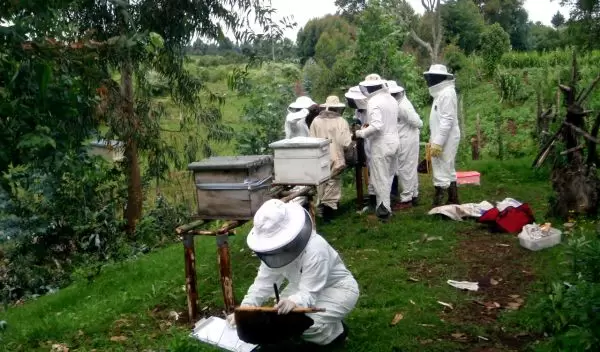
Protecting the honey-bearers
The honey bearers arrived in the early 17th century, carried into the United States by early European settlers. Apis mellifera--the name truly translates as bee honey-bearer, though they are better known as honey bees.
Over the ensuing centuries, they flourished in the temperate North American climate, so successful they've become an integral part of our agricultural economy, contributing more than $14 billion in pollination services each year. They're trucked to our apple orchards and blueberry farms, our fields of squash and watermelon.
During the last decade, however, the honey bearers have suffered. They've died off in alarming numbers, entire colonies collapsing into ruin. The culprit seems to be a complex quartet of factors--poor nutrition, parasites, pathogens and pesticides--and scientists are still uncovering how these stresses harm bees and how they can be prevented.
Could the answers to some of these questions lie in Apis mellifera's African ancestors?
"If we can understand the genetic and physiological mechanisms that allow African bees to withstand parasites and viruses, we can use this information for breeding programs or management practices in U.S. bee populations," says Christina Grozinger, director of the Center for Pollinator Research at Pennsylvania State University.
Grozinger was part of a National Science Foundation (NSF)-funded project researching East African honeybees, analyzing the health of bee populations at 24 sites across Kenya. The team included scientists from Penn State, the International Centre of Insect Physiology and Ecology (icipe) in Kenya and South Eastern Kenyan University.
NSF's Basic Research to Enable Agricultural Development, or BREAD, program funded the award. BREAD supports creative, fundamental research designed to help small-holder farms in the developing world. The program is a collaboration between NSF and the Bill & Melinda Gates Foundation.
"The BREAD partnership has allowed NSF to build and fully support international collaborations, as well as innovative proof-of-concept basic research with broad implications for global agriculture," says Jane Silverthorne, deputy assistant director of NSF's Biological Sciences Directorate, which funded the research. "This study continues to provide unique insights into how environmental conditions affect the health of honey bee colonies in Kenya."
In 2010, the team of researchers from icipe and Penn State first discovered the deadly Varroa mite in Kenyan bees. A tiny red beast that attaches, shield-like, to the back of a bee, Varroa feeds on hemolymph (bee blood). It transmits diseases and wreaks havoc with a bee's immune system. The parasite's full name--Varroa destructor--is apt; it is the culprit for thousands upon thousands of bee deaths in North America and Europe.
That research was the first time Varroa was documented in East Africa.
"Since Varroa is the most deadly parasite of honey bees and has decimated populations of honey bees wherever it has spread in the world, it was vital to track the effects of the introduction of Varroa on East African bee populations," Grozinger said.
So the team applied for the BREAD award and began analyzing honey bees across Kenya, studying how parasites, pathogens and viruses were affecting the African bees.
What they found was that--despite Varroa--the African bees were surviving, were tolerating the parasites. The bees did not seem to be actively fighting or removing the mites; instead, they had a higher tolerance for them. Researchers also discovered a link between elevation and Varroa: Bee colonies at higher elevations had higher instances of Varroa. This suggests a bee's environment may make it more or less susceptible to the mites. And since environment is also closely related to nutrition--higher elevations often have less flowering plants, which means less food options for honey bees--improving bee nutrition could be one way to combat Varroa.
The relationship between elevation, nutrition and pathogens needs to be examined further, but Grozinger calls it a "very intriguing" correlation. Increasing the diversity of flowering plant species in a landscape--one way to boost bee nutrition--could potentially help bees help themselves, by increasing a bee's natural ability to tolerate Varroa.
The research, published last year in PLOS One, is just a "first blush" at analyzing African bee populations, said Maryann Frazier, a senior extension associate at Penn State and another scientist on the project.
But she says it's important to study honey bees in other parts of the world, and not just because pollinators are a global resource (in Kenya, honey bees not only pollinate, but provide crucial income and nutrition for farmers and rural families).
"What we're really interested in are the mechanisms that allow them to be more resistant. And then we can use that knowledge to select for those behaviors and physiological traits."
Much about those mechanisms remains undiscovered. Frazier, Grozinger, their Kenyan counterparts and others from Penn State are sequencing whole genomes of individual bees collected from different parts of Kenya; this should allow them to identify specific genes that have helped the bees adapt to different environments and potentially resist different diseases. They're also analyzing whether different hive types--many Kenyan beekeepers use hollow logs or trees as hives--affect honey bee health and productivity.
Other NSF-funded honey bee projects are studying the role of gut microbes in bee health, how bees develop colony-level social immunity and much more: the foundation supports more than 250 current pollinator-related projects, many highlighted in the recent Pollinator Research Action Plan, a national strategy to better understand pollinator losses and improve pollinator health. And ensure the honey-bearers thrive for many years to come.
